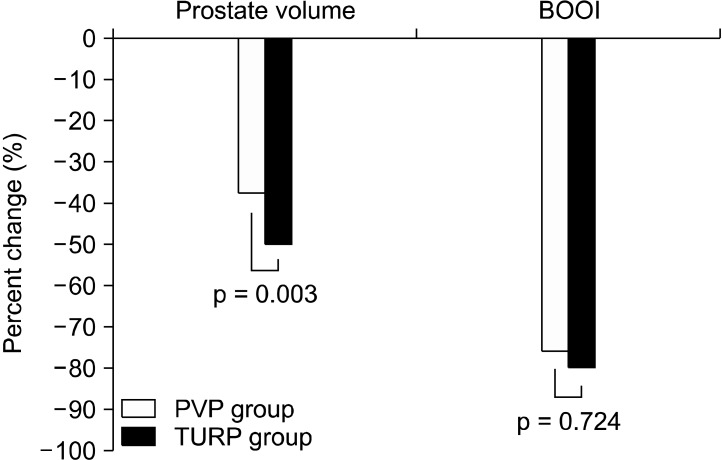World J Mens Health.
2012 Dec;30(3):160-165.
Can 80 W KTP Laser Vaporization Effectively Relieve the Obstruction in Benign Prostatic Hyperplasia?: A Nonrandomized Trial
- Affiliations
-
- 1Department of Urology, Samsung Medical Center, Sungkyunkwan University School of Medicine, Seoul, Korea. drswlee@skku.edu
- 2Department of Urology, Dankook University Hospital, Cheonan, Korea.
Abstract
- PURPOSE
There is little data evaluating the changes of severity of bladder outlet obstruction after 80 W-potassium-titanyl-phosphate (KTP) photoselective laser vaporization prostatectomy (PVP) by pressure-flow study. We evaluated the efficacy of PVP to relieve the obstruction in benign prostate hyperplasia (BPH) compared with transurethral resection of the prostate (TURP).
MATERIALS AND METHODS
This is a prospective, non-randomized single center study. The inclusion criteria were as follows: Men suffering from lower urinary tract symptoms (LUTS) secondary to BPH, age > or =50 years, International Prostatic Symptom Score (IPSS) > or =13, maximum flow rate (Qmax) < or =15 ml/s, and ability to give fully informed consent. Patients with neurogenic cause or detrusor underactivity were excluded. The IPSS, bother score, Qmax, postvoid residual volume (PVR), detrusor pressure at maximum flow rate (PdetQmax), bladder outlet obstruction index (BOOI), and prostate volume were measured before and 6 months after surgery and compared between PVP and TURP.
RESULTS
Sixty-seven patients (53 in PVP, 14 in TURP) were evaluable. In both groups, the IPSS, bother score, Qmax, and PVR had significantly improved (p<0.05), and there were no differences between the changes in those parameters. PVP could effectively reduce the PdetQmax, prostate volume, and BOOI from baseline (from 68.7+/-23.3 to 40.6+/-11.2 cmH2O, 49.5+/-16.3 to 31.3+/-12.1 ml, 49.8+/-25.6 to 9.8+/-20.7), similar to TURP. There were no differences in postoperative PdetQmax, prostate volume, or BOOI between the two groups. The percentage of patients with BOOI > or =40 was decreased from 64% to 4% in the PVP group and from 86% to 14% in the TURP group.
CONCLUSIONS
PVP could reduce the prostate volume effectively and relieve bladder outlet obstruction similar to TURP by the 6-month follow up in men with BPH.
Keyword
MeSH Terms
Figure
Reference
-
1. Bachmann A, Schürch L, Ruszat R, Wyler SF, Seifert HH, Müller A, et al. Photoselective vaporization (PVP) versus transurethral resection of the prostate (TURP): a prospective bi-centre study of perioperative morbidity and early functional outcome. Eur Urol. 2005; 48:965–971. PMID: 16126327.
Article2. Malek RS, Kuntzman RS, Barrett DM. Photoselective potassium-titanyl-phosphate laser vaporization of the benign obstructive prostate: observations on long-term outcomes. J Urol. 2005; 174:1344–1348. PMID: 16145416.
Article3. Sarica K, Alkan E, Lüleci H, Taşci AI. Photoselective vaporization of the enlarged prostate with KTP laser: long-term results in 240 patients. J Endourol. 2005; 19:1199–1202. PMID: 16359215.
Article4. Tan AH, Gilling PJ. Lasers in the treatment of benign prostatic hyperplasia: an update. Curr Opin Urol. 2005; 15:55–58. PMID: 15586032.
Article5. Schäfer W, Abrams P, Liao L, Mattiasson A, Pesce F, Spangberg A, et al. International Continence Society. Good urodynamic practices: uroflowmetry, filling cystometry, and pressure-flow studies. Neurourol Urodyn. 2002; 21:261–274. PMID: 11948720.
Article6. Abrams P. Bladder outlet obstruction index, bladder contractility index and bladder voiding efficiency: three simple indices to define bladder voiding function. BJU Int. 1999; 84:14–15. PMID: 10444116.
Article7. Hakenberg OW, Helke C, Manseck A, Wirth MP. Is there a relationship between the amount of tissue removed at transurethral resection of the prostate and clinical improvement in benign prostatic hyperplasia. Eur Urol. 2001; 39:412–417. PMID: 11306879.
Article8. Te AE, Malloy TR, Stein BS, Ulchaker JC, Nseyo UO, Hai MA, et al. Photoselective vaporization of the prostate for the treatment of benign prostatic hyperplasia: 12-month results from the first United States multicenter prospective trial. J Urol. 2004; 172:1404–1408. PMID: 15371855.
Article9. Kuntzman RS, Malek RS, Barrett DM, Bostwick DG. Potassium-titanyl-phosphate laser vaporization of the prostate: a comparative functional and pathologic study in canines. Urology. 1996; 48:575–583. PMID: 8886063.
Article10. Kumar SM. Photoselective vaporization of the prostate: a volume reduction analysis in patients with lower urinary tract symptoms secondary to benign prostatic hyperplasia and carcinoma of the prostate. J Urol. 2005; 173:511–513. PMID: 15643231.
Article11. Sandhu JS, Ng C, Vanderbrink BA, Egan C, Kaplan SA, Te AE. High-power potassium-titanyl-phosphate photoselective laser vaporization of prostate for treatment of benign prostatic hyperplasia in men with large prostates. Urology. 2004; 64:1155–1159. PMID: 15596189.
Article
- Full Text Links
- Actions
-
Cited
- CITED
-
- Close
- Share
- Similar articles
-
- The Evolution of KTP Laser Vaporization of the Prostate
- Changes in Serum Prostate-Specific Antigen Levels after Potassium-Titanyl-Phosphate (KTP) Laser Vaporization of the Prostate
- Evaluation of the Quality of Life and the Efficacy of Treatment after High Power Potassium-titanyl-phosphate(KTP) Laser Vaporization for Patients with a Prostate Volume Greater than 40cc
- The Effectiveness of Transurethral Resection of the Prostate Combined with High Power Potassium-titanyl-phosphate(KTP) Laser Vaporization for Patients with a Prostate Volume Greater than 45cc
- Dystrophic Calcification and Stone Formation on the Entire Bladder Neck After Potassium-titanyl Phosphate Laser Vaporization for the Prostate: A Case Report



